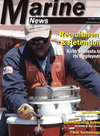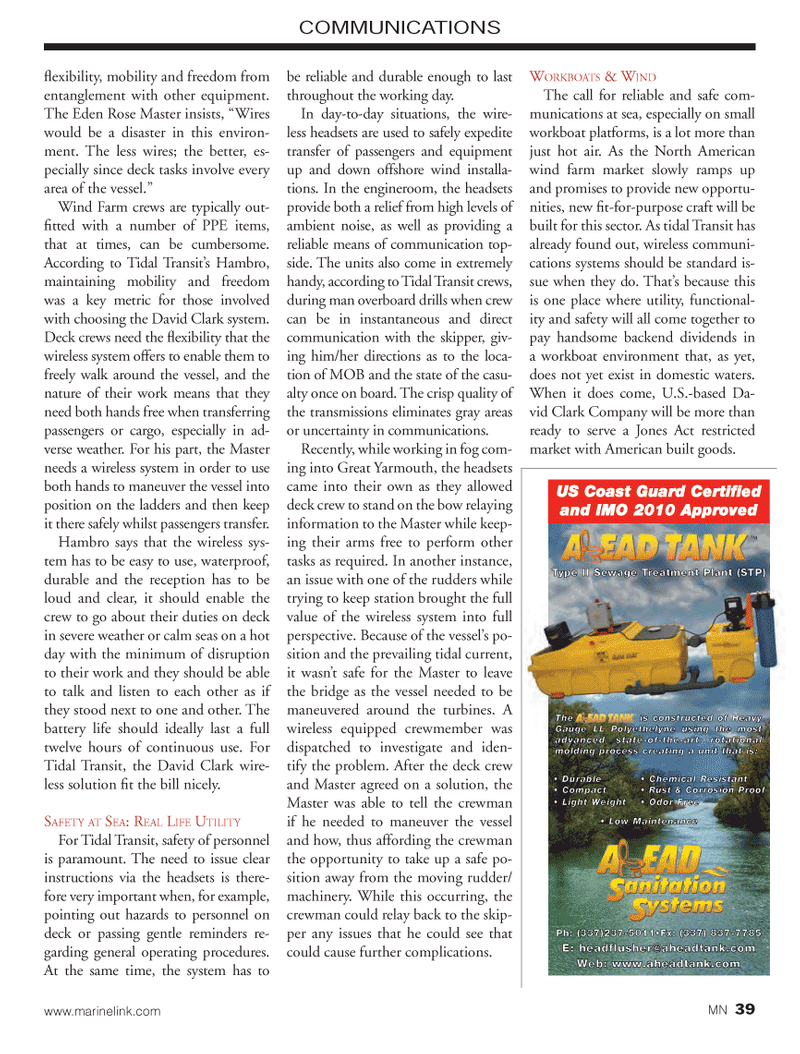
Page 39: of Marine News Magazine (October 2013)
Manning: Recruitment & Retention
Read this page in Pdf, Flash or Html5 edition of October 2013 Marine News Magazine
ß exibility, mobility and freedom from entanglement with other equipment. The Eden Rose Master insists, ÒWires would be a disaster in this environ- ment. The less wires; the better, es- pecially since deck tasks involve every area of the vessel.Ó Wind Farm crews are typically out- Þ tted with a number of PPE items, that at times, can be cumbersome. According to Tidal TransitÕs Hambro, maintaining mobility and freedom was a key metric for those involved with choosing the David Clark system. Deck crews need the ß exibility that the wireless system offers to enable them to freely walk around the vessel, and the nature of their work means that they need both hands free when transferring passengers or cargo, especially in ad-verse weather. For his part, the Master needs a wireless system in order to use both hands to maneuver the vessel into position on the ladders and then keep it there safely whilst passengers transfer. Hambro says that the wireless sys- tem has to be easy to use, waterproof, durable and the reception has to be loud and clear, it should enable the crew to go about their duties on deck in severe weather or calm seas on a hot day with the minimum of disruption to their work and they should be able to talk and listen to each other as if they stood next to one and other. The battery life should ideally last a full twelve hours of continuous use. For Tidal Transit, the David Clark wire- less solution Þ t the bill nicely. SAFETY AT SEA: REAL LIFE UTILITY For Tidal Transit, safety of personnel is paramount. The need to issue clear instructions via the headsets is there- fore very important when, for example, pointing out hazards to personnel on deck or passing gentle reminders re- garding general operating procedures. At the same time, the system has to be reliable and durable enough to last throughout the working day. In day-to-day situations, the wire- less headsets are used to safely expedite transfer of passengers and equipment up and down offshore wind installa- tions. In the engineroom, the headsets provide both a relief from high levels of ambient noise, as well as providing a reliable means of communication top- side. The units also come in extremely handy, according to Tidal Transit crews, during man overboard drills when crew can be in instantaneous and direct communication with the skipper, giv- ing him/her directions as to the loca- tion of MOB and the state of the casu-alty once on board. The crisp quality of the transmissions eliminates gray areas or uncertainty in communications. Recently, while working in fog com- ing into Great Yarmouth, the headsets came into their own as they allowed deck crew to stand on the bow relaying information to the Master while keep- ing their arms free to perform other tasks as required. In another instance, an issue with one of the rudders while trying to keep station brought the full value of the wireless system into full perspective. Because of the vesselÕs po- sition and the prevailing tidal current, it wasnÕt safe for the Master to leave the bridge as the vessel needed to be maneuvered around the turbines. A wireless equipped crewmember was dispatched to investigate and iden- tify the problem. After the deck crew and Master agreed on a solution, the Master was able to tell the crewman if he needed to maneuver the vessel and how, thus affording the crewman the opportunity to take up a safe po- sition away from the moving rudder/ machinery. While this occurring, the crewman could relay back to the skip- per any issues that he could see that could cause further complications. WORKBOATS & W INDThe call for reliable and safe com- munications at sea, especially on small workboat platforms, is a lot more than just hot air. As the North American wind farm market slowly ramps up and promises to provide new opportu- nities, new Þ t-for-purpose craft will be built for this sector. As tidal Transit has already found out, wireless communi- cations systems should be standard is- sue when they do. ThatÕs because this is one place where utility, functional- ity and safety will all come together to pay handsome backend dividends in a workboat environment that, as yet, does not yet exist in domestic waters. When it does come, U.S.-based Da- vid Clark Company will be more than ready to serve a Jones Act restricted market with American built goods. mmÜÜWW==EEPPPPTTFFOOPPTTJJRRMMNNNN� � ccññWW==EEPPPPTTFF==UUPPTTJJTTTTUURRbbWW==ÜÜÉÉ~~ÇÇÑÑääììëëÜÜÉÉêê]]~~ÜÜÉÉ~~ÇÇíí~~ååââKKÅÅççããttÉÉÄÄWW==ïïïïïïKK~~ÜÜÉÉ~~ÇÇíí~~ååââKKÅÅççãã�+�+==``ÜÜÉÉããááÅÅ~~ää==ooÉÉëëááëëíí~~ååíí==�+�+==ooììëëíí==CC==``ççêêêêççëëááççåå==mmêêççççÑÑ====�+�+==llÇÇççêê==ccêêÉÉÉÉ==�+�+==aaììêê~~ÄÄääÉÉ==�+�+==``ççããéé~~ÅÅíí====�+�+==iiááÖÖÜÜíí==ttÉÉááÖÖÜÜííqqóóééÉÉ==ffff==ppÉÉïï~~ÖÖÉÉ==qqêêÉÉ~~ííããÉÉååíí==mmää~~ååíí==EEppqqmmFFrp=`ç~ëí=dì~êÇ=`ÉêíáÑáÉÇ ~åÇ=fjl=OMNM=^ééêçîÉÇ qqÜÜÉÉááëë==ÅÅççååëëííêêììÅÅííÉÉÇÇ==ççÑÑ==eeÉÉ~~îîóódd~~ììÖÖÉÉ==iiii==mmççääóóÉÉííÜÜÉÉääóóååÉÉ==ììëëááååÖÖ==ííÜÜÉÉ==ããççëëíí~~ÇÇîî~~ååÅÅÉÉÇÇ==ëëíí~~ííÉÉJJççÑÑJJííÜÜÉÉJJ~~êêíí==êêççíí~~ííááççåå~~ääããççääÇÇááååÖÖ==ééêêççÅÅÉÉëëëë==ÅÅêêÉÉ~~ííááååÖÖ==~~==ììååááíí==ííÜÜ~~íí==ááëëWW�+�+==iiççïï==jj~~ááååííÉÉåå~~ååÅÅÉÉCOMMUNICATIONS www.marinelink.com MN 39MN October2013 Layout 32-49.indd 39MN October2013 Layout 32-49.indd 399/30/2013 11:32:42 AM9/30/2013 11:32:42 AM

 38
38

 40
40
